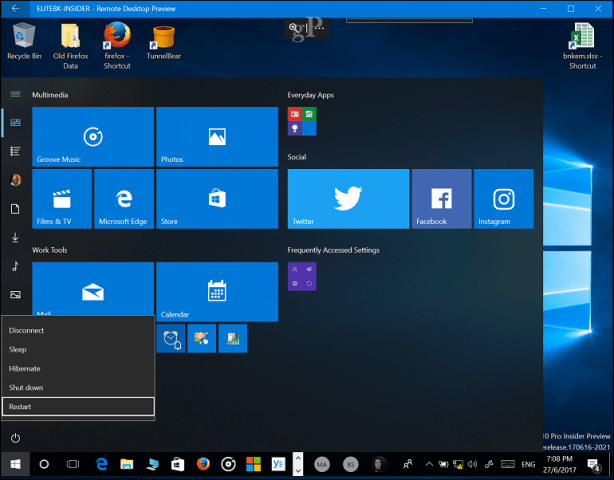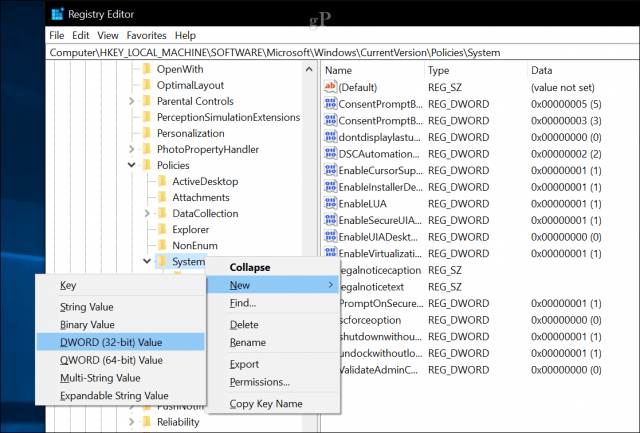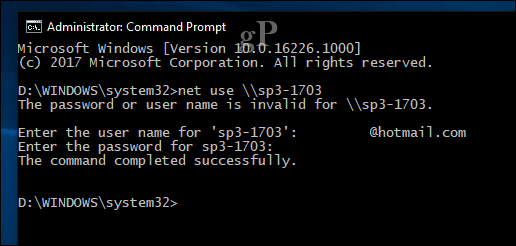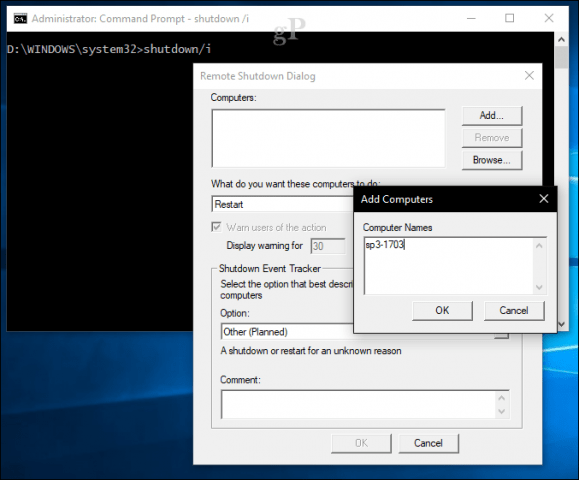How to Remote Shutdown or Restart Your Windows 10 PC

Too lazy to stand up and push the power button on the computer in the other room? Here’s your solution.
If you have multiple always-on Windows 10 PCs set up in your home in different rooms, it can be a chore to shut down or reboot each one. Instead of physically visiting each machine, you can remotely reboot or shut down each machine. This article takes a quick look at a couple of options.
Shut Down or Restart a Windows 10 PC Using Remote Desktop
The simplest way to shut down or reboot a remote Windows 10 computer is to connect via Remote Desktop Protocol (RDP) and then click Start > Restart or Shut Down.


You’ll need to be running Windows 10 Pro, Education, or Enterprise on each computer for this to work. If you have a mix of operating systems on your network, you can use TightVNC to remotely control a PC from Mac, Windows, or Linux.
Shut Down or Reboot a Networked Windows PC from the Command Line
As an alternative to VNC or RDP, you can shut down or restart a networked PC from the command line. Connect your Windows PCs to the same network, then follow the steps below.
Note: For this method, you need to tweak some registry settings. It’s a fairly simple change, but be aware that misconfiguring your registry can cause system instabilities, so follow the steps carefully.
- On the computer that you want to reboot or shut down remotely, press Windows key + R, type: regedit then hit Enter on your keyboard.
- Navigate to the following registry key Computer\HKEY_LOCAL_MACHINE\Software\Microsoft\Windows\CurrentVersion\Policies\System. If you are running Windows 10 1703 or later, you can quickly find registry keys by copying and pasting the registry path into the address bar and hit Enter.
- Right-click on the System folder, select New > DWORD (32-bit) Value.


- Enter the following label: LocalAccountTokenFilterPolicy.


- Double-click the value, then change the value to 1.


- Exit the registry, then restart your computer to confirm changes. Now you are ready to restart or shut down remotely.
- Press Windows key + X, click Command Prompt (Admin).
- At the command prompt, log into the machine. Example: net use \\MachineName then hit Enter. Enter your username on the machine or Microsoft Account ID followed by your password.


- At the command prompt, type shutdown -r -m \\MachineName -t -01 then hit Enter on your keyboard.


The remote computer should automatically shut down or restart depending on the switches you choose. Notice, the command is similar to performing it locally. You can always specify a longer period for your shutdown or restart. In my case, I chose one minute. If you want to ensure the machine shuts down or restarts, you can add the /f switch, example: shutdown /m \\ MachineName /r /f. This will close out all open applications running on the remote machine.


Tip: An even easier command to use is the shutdown\i command. This will bring up a graphical dialog that lets you select the remote computer or enter its name using the Add button. You can then specify whether you want to shut down or restart and even add a comment.


Automate Multiple Shutdown/Restart Using Batch File
Connecting remotely and shutting down a computer is fine as a one-off, but what if you want to shut down or reboot a computer at the same time every day? If you have to do this through the command line every time, it becomes a drag real quick. An easier option is to automate restarting or shutting down all your computers. Fire up Notepad, then enter the remote shutdown command with each computer’s network name on a new line.
Fire up Notepad, then enter the remote shutdown command with each computers network name on a new line. For example:
shutdown -r -m \\DELL-PC1 -t -01
shutdown -r -m \\SURFACEPRO -t -01
shutdown -r -m \\MachineName -t -01
You can modify the switches based on whether you want to restart (-r) or shutdown (-s). Proceed to save the file using the .bat extension on your desktop, for example, shutdownrestart.bat
That’s it! Once you’ve mastered remote shutdowns, be sure to check out our Wake on LAN article. Great for scenarios where you need to wake up a machine to access resources.
Drop a line in the comments and let us know how it goes. This took a bit of trial and error to work reliably, so I am interested in knowing if these instructions go smoothly.
19 Comments
Leave a Reply
Leave a Reply







darren
January 26, 2018 at 5:26 pm
access denied 05d
Luigi Monk
February 19, 2019 at 10:10 am
This is what I did:
1. Go to services (Start – Run – services.msc)
2. Activate Remote Registry
3. Set startup to automatic
4. Go to Firewall Settings (Allow app through windows firewall)
5. Allow Windows Management Instrumentation (WMI)
6. Enter Registry editor (Start – Run – regedit)
7. Find Computer\HKEY_LOCAL_MACHINE\Software\Microsoft\Windows\CurrentVersion\Policies\System
8. New DWORD32 LocalAccountTokenFilterPolicy
9. Set LocalAccountTokenFilterPolicy Value to 1
10. Reboot
Faiz Khan
July 23, 2019 at 2:54 am
Access is denied (5)..
i am done all method and after result is …Access is denied (5)
Laserstrahl
September 29, 2019 at 5:12 am
Same, not working for me either.
Shahid
February 25, 2020 at 8:56 am
It works if you have proper privileges
I was able to restart the locked domain computer
Used this
shutdown -r -m \\MachineName -t -01David Bowsher
November 30, 2021 at 7:32 am
You also need to have the remote computer basically unprotected. Firewall OFF. Malware Scanner OFF. You have to make the system so vulnerable that I wouldn’t have it on my network in that condition.
jim
December 20, 2022 at 10:57 am
No you don’t!! You can set a GPO to allow remote management from a device or network through the firewall.
domenico
March 21, 2020 at 2:15 am
Dears,
for me it works, but I have a problems with batch file. It doesn’t work even if I have used administrator privileges. Help..
Domenico
March 21, 2020 at 2:38 pm
problem with batch file solved!!!
Used this:
shutdown -m \\localipaddress -s -t 00 -c “Comment”
Matias
March 26, 2020 at 3:45 pm
It doesn’t work for me either. No explanation given at commanding machine.
Remote machine does not get notice of the shutdown command :-(
Ed Eaglehouse
August 13, 2020 at 5:08 am
`shutdowni` is not a valid command. It’s `shutdown /i`.
Pinkybum
December 23, 2020 at 11:50 am
Just go to the desktop and hit Alt-F4. A dialog will pop up giving you all the options.
Steve Krause
December 24, 2020 at 12:05 pm
Hello – ALT-F4 will either close the active window or, give you a shutdown, restart, sleep, log off. If connected to a Remote Windows 10 PC, it will also give you the same popup. However, it’s not a command that works to “remotely” shutdown a Windows 10 system.
Ed Eaglehouse
December 28, 2020 at 4:56 am
The point of this article is about shutting down or restarting a _remote_ machine. If you can’t get a remote connection, all you’ll be doing with your suggestions is shutting down or restarting your _local_ machine.
me
February 12, 2021 at 1:53 pm
there is no dash (-) before the 01 it works like this shutdown -r -m \\MachineName -t 01 … no dash before the 01
Mohamed Fat'hy
November 23, 2021 at 12:05 am
Thanks for these well explained information.
I’ve noticed a dash before the time in seconds which makes the command to fail:
shutdown -r -m \\MachineName -t (((( -01 ))))
also there is a space between the command “shutdown” and the switch “/i”.
sandeep
December 20, 2021 at 4:52 pm
Better to use alt+ctrl+end
L
October 3, 2022 at 9:57 am
Why does it say “Machinename: Failed to connect to registry. (11001)” ?
Alan Keno
February 3, 2023 at 8:48 am
Is it possible to create a batchfile with the shutdown or restart action that calls on a hostlist with a bunch of computers to get that action?